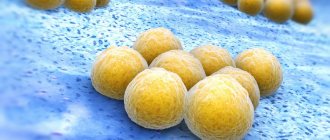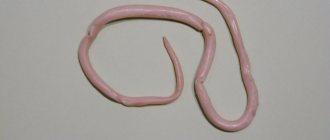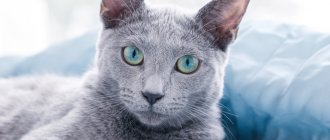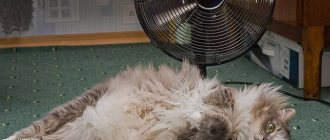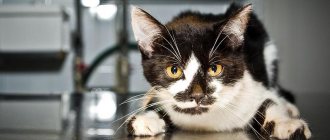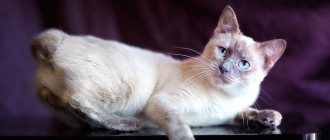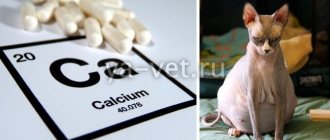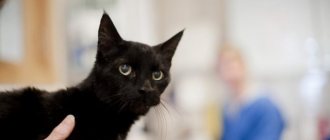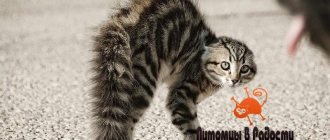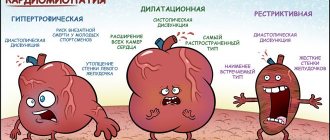Types of rhinoscopy, technique
The method of conducting rhinoscopy involves the use of special equipment - flexible and rigid probes (endoscopes) of different sizes. According to the technique of rhinoscopy, there are:
- anterior (straight, antegrade);
- posterior (retrograde).
When examining the nasal cavity during anterior rhinoscopy, the veterinarian inserts the endoscope from the side of the animal's nostrils towards the nasopharynx. In the posterior case, a flexible probe (fiberscope) with a camera on the tip is used, which is inserted into the cat’s mouth (through the choanae) from the nasopharynx. This technique allows you to determine the condition of the soft palate, pharynx, nasopharynx, and vomer.
In most cases, when diagnosing the nasal cavity, two rhinoscopy techniques are used simultaneously.
Important! Rhinoscopy in veterinary medicine is used not only for diagnosis, but also during medical procedures. This technique is used to remove tumors, polyps, and cysts in the nose of animals.
When performing rhinoscopy, a specialist can remove a tumor, a small-diameter neoplasm, foreign bodies found in the upper organs of the respiratory system, and take a tissue sample for bacteriological culture, targeted biopsy, and other tests and diagnostic tests.
Indications for examination of the nasopharynx
The symptom of constant nosebleeds is a sign of disease, foreign body entry or tumor formation. The discharge can be one-sided or two-sided, resulting in difficulty breathing. If after drug treatment the situation does not improve, then veterinarians prescribe rhinoscopy. It allows you to perform a biopsy aimed at a specific area, remove foreign bodies or remove tumors without incisions - the ability to perform minimally invasive and microsurgical operations.
Your pet needs a rhinoscopy if:
- the cat is breathing heavily through his nose;
- bulging eyes appeared;
- there were problems with swallowing;
- shakes his head or rubs it against various objects;
- painful sensations when palpating the nose;
- blood, pus and mucus leak from the sinuses;
- the deformation of the back of the spout is visually visible;
- the animal sneezes frequently;
- prolonged treatment with drugs does not produce results.
Diagnostic procedures include a biopsy if formations are detected in the nose.
After diagnosis, the doctor will be able to:
- assess violations of the integrity of the mucous membrane;
- detect the causes of bleeding;
- if formations are detected, perform a biopsy;
- select material for bacterial inoculation.
Rhinoscopy allows you to determine the cause in the early stages of the disease, in contrast to the radiographic method, which is used if the disease has affected most of the nasal cavity. If a white coating is visible in the cat’s mouth, then using an endoscope you can take a biopsy to check for a fungal infection. Next, the tests are sent for histological, bacteriological or mycological examination. This is the only way to identify the true cause of rhinitis in cats.
Preparing a cat for rhinoscopy
Despite the safety of rhinoscopy, a prerequisite for this endoscopic examination technique is general anesthesia.
To reduce the risk of complications that arise when putting an animal into deep sleep (anesthesia), the diagnostic procedure is performed on an empty stomach. The cat is kept on a starvation diet for 12-24 hours. Access to drinking water is limited 3-4 hours before. Such preparation is necessary so that during the administration of veterinary drugs the animal does not choke on vomit.
Before setting a date for rhinoscopy, the veterinarian conducts a complete examination of the cat. To minimize risks, we recommend showing your pet to a veterinarian-cardiologist or anesthesiologist.
After the procedure, we do not recommend taking the cat home immediately, since one should not exclude possible complications caused by anesthesia (lethargy, anaphylactic shock, decreased temperature). If necessary, the veterinarian will provide emergency assistance to the animal.
Types of diagnostics
Rhinoscopy is divided into 2 types: diagnostic and operational rhinography. The first is used to diagnose the required area for damage by fungi, infections, injuries or oncology. This type of diagnosis is relevant for purulent bloody discharge from the nose of cats and impaired nasal breathing. To determine the presence of bacterial infections, a cat's microflora is cultured to determine sensitivity to antibiotics. In case of tumor or inflammation, a fragment of the mucosa is excised for testing. After these studies, soft tissues are quickly restored.
According to the access method, this operation is divided into posterior and anterior. Using posterior rhinoscopy, the pharynx, soft palate, and nasopharynx are examined. Next, they carry out the anterior examination, examining the nasal passages. In cases where the nasal passage is closed, a microsurgical operation is performed to allow entry into the cavity. For this procedure, anesthesia must be used in order to carry out the necessary manipulations with a minimum amount of injury to the cat. To stop bleeding after surgery, a cotton swab is inserted into the nose, which is removed before discharge. They are allowed to go home after fully awakening from the effects of the sedative gas.
Candidate of Veterinary Sciences Kuleshova O.A. focuses on the fact that if a cat has an outward manifestation of a respiratory infection, then before starting the procedure it is necessary to rinse the mucous membrane to obtain reliable results.
Contraindications to rhinoscopy in cats
Rhinoscopy has a number of contraindications, including:
- severe nosebleeds;
- chronic pathologies of the cardiovascular system;
- intolerance, impossibility of putting an animal under anesthesia (age);
- injured ENT organs;
- pregnancy, lactation;
- severe pain in the sinuses.
Price for cat rhinoscopy
The cost of the intervention consists of the cost of the rhinoscopy procedure itself, anesthesia and consumables that will be required during the operation. You can find out more about the prices for endoscopic examinations in the Prices section of our website.
In our clinic we use rigid endoscopes from KARL STORZ with optical tube diameters of 2.4 cm or 2.7 cm. Flexible endoscopes are represented by a gastroscope from Huger and a bronchoscope from LOMO. This equipment allows us to carry out most of the necessary studies and manipulations in the nasal cavity for the diagnosis and treatment of chronic and acute rhinitis in cats.
Otoscopy in animals (video-otoscopy)
Otoscopy in cats and dogs - ear diseases are one of the most common pathologies in the field of veterinary medicine for small animals. They often present both diagnostic and therapeutic challenges. Otoscopy has revolutionized the practice of otology in veterinary medicine. For the specialist, it provided the opportunity to better visualize changes in the middle ear. Video otoscopy provides the ability to directly observe various procedures that can be performed using endoscopy. For example: careful toilet of the ear canal, biopsy, removal of a foreign body and myringotomy (puncture of the eardrum to drain purulent contents in otitis media.
Bronchoscopy in dogs
Bronchoscopy is a shorter name for the endoscopic method of assessing the lumen of the trachea, bronchi and assessing the mucous membrane - tracheobronchoscopy. With this method, the doctor has the opportunity to visually assess the condition of the pharynx, epiglottis, glottis and ligaments, the mucous membrane of the larynx, trachea and bronchi, their contents, see the narrowing of the tracheal lumen (for example, during collapse), the presence of formations and foreign bodies. Also, as with other studies, it is possible to perform a biopsy, take contents for analysis, and also remove foreign bodies. Diagnostic bronchoscopy is a necessary step in preparation for tracheal stenting with progressive collapse and direct placement of an endotracheal stent. Indications for bronchoscopy in dogs and other animals: traces of blood in the sputum; persistent cough with no obvious cause; change or complete disappearance of voice, suspicion of pulmonary infections; violation of the breathing process; pathological changes according to the results of x-ray examination.
Features of pet care
After the nose job has been performed, the cat should be put on a special collar, which he wears until the stitches heal. With normal tissue regeneration, the cat recovers within 14 days. To avoid suppuration, antibiotics are prescribed. The animal should be provided with rest and physical activity should be limited. Dry food should be soaked in water or switched to wet food. The food should be slightly warmed, but it should not be hot or cold. It is advisable to twist meat or fish into minced meat. The cat is not allowed to stay in the sun for a long time and, to avoid bleeding, it is better to move the pet to dense shade.
What is rhinoscopy
Rhinoscopy is a relatively simple procedure. The examination is carried out under anesthesia, after intubation. Intubation is necessary to prevent air from circulating through the nasal cavity.
The examination is carried out in the “sphinx” layout. A hard pad is placed between the head and the front paws to stabilize but not secure the head. Before the examination, a thorough examination of the oral cavity and pharynx is carried out. For a detailed examination, an otoscope with a separate diode is used:
- The otoscope or rhinoscope is brought to the nostril at an angle of 45°.
- Pressing the lobe, the otoscope or rhinoscope is carefully inserted into the nostril.
- The otoscope or rhinoscope is rotated until its imaging line is parallel to the nasal cavity.
- During the love spell process, the otoscope or rhinoscope is inserted deeper with minimal damage to the mucous membranes.
There is a camera at the tip of the otoscope, so if the cat has a severe runny nose, visibility will be greatly reduced after insertion. If the chamber is completely blocked by mucus, the otoscope is removed, the cavity is drained and the procedure begins again. Modern rhinoscopes have a suction function, which is why it is better to entrust rhinoscopy to a veterinarian-ENT specialist who has modern equipment.
Rhinoscopy is the priority examination method if it is necessary to remove a tumor or foreign object. Professional rhinoscopes are equipped not only with suction, but also with special forceps, which are used to remove tumors with minimal damage.
How is it carried out?
Magnetic resonance imaging is used to detect polyps that may appear due to inflammatory processes.
If local treatment is not effective, then the next method for examination is MRI. This diagnosis shows the presence of polyps or other formations that appear after chronic inflammation, inflammatory processes in the nasal passages. After the MRI results are obtained, the animal is prepared for rhinoscopy. Having discovered an infection with pathological flora in the sinuses and formations in the nasopharyngeal space, this is eliminated surgically. When a polyp is found in the nasal cavity or there is simply inflammation, rhinoscopy is performed along with histology, cytology and bacterial culture.
When performing posterior rhinoscopy, the animal’s mouth is fixed with a special mouth dilator. If a foreign body is detected, it is removed immediately if the size and shape allows this to be done without injury. If this is not possible, a planned surgical operation is prescribed. A mandatory examination before surgery includes a visit to a cardiologist and an anesthesiologist to determine the existing risks.
Not every veterinary clinic has equipment for performing rhinoscopy. If the behavior and condition of the animal has changed, it is necessary to urgently consult a doctor for early diagnosis of pathological processes. Therefore, rhinoscopy in cats is not only about diagnosing the condition of the nasal and oral cavities, but also about obtaining a complete diagnosis with the study of the tissues of the mucous membrane. This is where the method differs from MRI.
